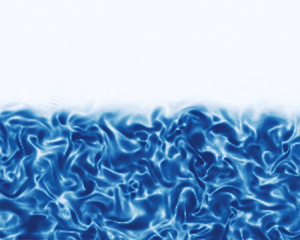Article contents
Asymptotic scaling laws for the irrotational motions bordering a turbulent region
Published online by Cambridge University Press: 05 May 2021
Abstract

Turbulent flows are often bounded by regions of irrotational or non-turbulent flow, where the magnitude of the potential velocity fluctuations can be surprisingly high. This includes virtually all turbulent free-shear flows and also turbulent boundary layers, and is particularly true near the so-called turbulent/non-turbulent interface (TNTI) layer, which separates the regions of turbulent and non-turbulent fluid motion. In the present work, we show that in the non-turbulent region and for distances  $x_2$ sufficiently far from the TNTI layer, the asymptotic variation laws for the variance of the velocity fluctuations
$x_2$ sufficiently far from the TNTI layer, the asymptotic variation laws for the variance of the velocity fluctuations  $\langle u_i^{2} \rangle$ (
$\langle u_i^{2} \rangle$ ( $i=1,2,3$), Taylor micro-scale
$i=1,2,3$), Taylor micro-scale  $\lambda$ and viscous dissipation rate
$\lambda$ and viscous dissipation rate  $\varepsilon$ depend on the shape of the kinetic energy spectrum in the infrared region
$\varepsilon$ depend on the shape of the kinetic energy spectrum in the infrared region  $E(k) \sim k^{n}$. Specifically, by using rapid distortion theory (RDT), we show that for Saffman turbulence (
$E(k) \sim k^{n}$. Specifically, by using rapid distortion theory (RDT), we show that for Saffman turbulence ( $E(k) \sim k^{2}$), we obtain the asymptotic laws
$E(k) \sim k^{2}$), we obtain the asymptotic laws  $\langle u_i^{2} \rangle \sim x_2^{-3}$ (
$\langle u_i^{2} \rangle \sim x_2^{-3}$ ( $i=1,2,3$),
$i=1,2,3$),  $\lambda \sim x_2$ and
$\lambda \sim x_2$ and  $\varepsilon \sim x_2^{-5}$. Additionally, we confirm the classical results obtained by Phillips (Proc. Camb. Phil. Soc., vol. 51, 1955, p. 220) for Batchelor turbulence (
$\varepsilon \sim x_2^{-5}$. Additionally, we confirm the classical results obtained by Phillips (Proc. Camb. Phil. Soc., vol. 51, 1955, p. 220) for Batchelor turbulence ( $E(k) \sim k^{4}$), with
$E(k) \sim k^{4}$), with  $\langle u_i^{2} \rangle \sim x_2^{-4}$ (
$\langle u_i^{2} \rangle \sim x_2^{-4}$ ( $i=1,2,3$),
$i=1,2,3$),  $\lambda \sim x_2$ and
$\lambda \sim x_2$ and  $\varepsilon \sim x_2^{-6}$. The new theoretical results are confirmed by direct numerical simulations (DNS) of shear-free turbulence and are shown to be independent of the Reynolds number. Therefore, these results are expected to be valid in other flow configurations, such as in turbulent planar jets or wakes, provided the kinetic energy spectra in the turbulence region can be described by a Batchelor or a Saffman spectrum.
$\varepsilon \sim x_2^{-6}$. The new theoretical results are confirmed by direct numerical simulations (DNS) of shear-free turbulence and are shown to be independent of the Reynolds number. Therefore, these results are expected to be valid in other flow configurations, such as in turbulent planar jets or wakes, provided the kinetic energy spectra in the turbulence region can be described by a Batchelor or a Saffman spectrum.
Information
- Type
- JFM Papers
- Information
- Copyright
- © The Author(s), 2021. Published by Cambridge University Press
References
REFERENCES
- 5
- Cited by


